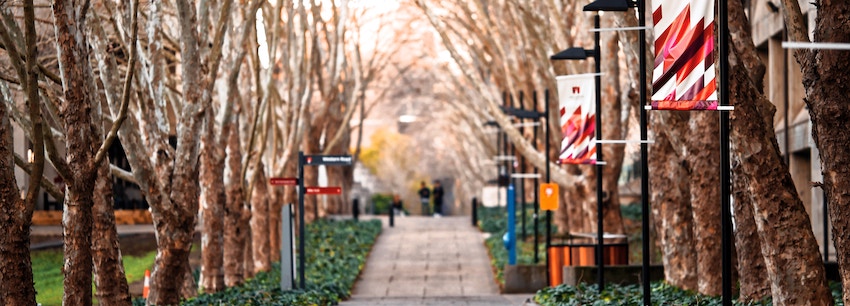University Printing Best Practices: Automate Marketing and Stretch Budgets by Department

Universities rely on printed materials to engage their students and alumni across the course of a lifetime. There are over 4,500 colleges and universities in the United States, and for high school students and their families, it often feels like they are getting contacted by every single one. Email may be the most common means of contact, but a crowded inbox full of similar subject lines means this kind of communication is easily ignored by prospects. Direct mail, on the other hand, is far more likely to catch the attention of not only prospective students, but the family members helping them make the decision about higher education.
University printing best practices can drive big impact on marketing business processes and results in enrollment numbers.
While Admissions does a lot of printing, their materials, like their process, are just the beginning. After admission, the internal world of higher education is full of its own diversity of printed materials. Each department has unique catalogues, letterhead, and flyers, while athletic teams tweak the university logo and other marketing materials into their own distinct brand. And after a student graduates, their engagement as an alumnus also depends in part on printed materials, like an alumni magazine and invitations to events.
A key factor we’ve seen in working with dozens of different higher-ed organizations, is how quickly they need to make changes and how using university printing best practices can enable brand compliance. Adding a new sponsor to a program or sign; updating a viewbook with timely photos; an accurate course catalogue; even offering the best-looking swag at a college fair; these all rely on a sophisticated print communications partner that has digital asset management know-how and automated processes that can turn an order quickly and usually with short notice. That’s where we’ve also seen how overwhelmed a marketing and communications department can become without a good printer on-call.
Different focus areas at institutions of higher education each have hidden efficiencies that can be achieved through the right kind of partnership with a print vendor. Here’s where we have learned how university printing best practices can leverage their budgets through both technology and better processes.
University Printing Best Practices by Department
Admissions: Stand Out in The Crowd
For admissions, the primary goal is for printed materials to capture the experience and energy that make the university unique. These materials need to help the school stand out and stay relevant. The viewbook is one key piece of this strategy: a printed, multi-page brochure that students and their families can review to educate themselves on key differentiators and programming suited to their interests. This book is essentially a primer about the culture and offerings of the institution itself. Within a university, different academic departments or athletic groups may have their own viewbooks to offer an even deeper look into life on campus and the student experience.
Individual components of the Admissions’ department print projects, such as their size or creative folding, are a big part of what makes them stand out. But even when the university isn’t doing anything out of the norm, these decisions can also be a hidden cost-driver. We helped one Indiana based university achieve cost savings after recommending a modest 1/8” reduction in the height of their viewbook. With no change in the width, this didn’t require any significant re-design from the university, or make much visible effect on the viewbook. But by applying these simple university printing best practices, this allowed them to save $750 when went to print 2,500 viewbooks. Now, similar savings can be achieved making the same change every time they print a fresh version of an older viewbook.
Athletics: School Spirit Shouldn’t be a Chore
The Athletic department at any university is its own marketing ecosystem, with a high demand for time-sensitive printed materials. Events like games, invitationals, camps, even practices are scheduled in advance and can’t move. This in turn means the deadlines for collateral like programs, posters, signage, and athletic gear are totally inflexible. At the same time, decision makers in the university Athletic department might need to change information like sponsorship, event location, team roster, or other details even the day before the event. This information is high-stakes and extremely important to print accurately, but when something is needed the next day, that might feel impossible. In our experience, being agile when applying university printing best practices to evolving athletic programs is essential in staying engaged with its fanbase (which often encompasses the entire city, alumni, and students).
In-House vs. Outsourced Printing
While universities may have on-campus print facilities, certain departments benefit from call outsourcing. Between turnaround time, unique needs, and brand standards, you want to be working with a printing partner familiar with your brand and your mailing guidelines. This partnership helps avoid scenarios like missing your exact brand color, using the wrong version of the logo or mascot, or other quality issues that can deepen an already stressful situation right at the last moment. This also helps reduce cost by minimizing the need for reprints and rush orders. When university marcom groups have to pivot based on unpredictable playoffs or big events like homecoming, having a reliable partner on-the-go is essential.
Another priority for athletics is branded products and apparel. Fineline helped one university client save on total unit price by placing larger orders and managing their inventory and fulfillment. This basically automated their e-commerce, pricing, inventory and nation-wide mailing for online orders. Because when your team’s in the Final Four, marketing wants to be worrying about PR and national coverage, not counting remaining units on jerseys.
Advancement and Alumni Engagement: Make it Relevant, Make it Right
The advancement and alumni engagement departments oversee fundraising and grow the university endowment through initiatives like planned giving. They also track placement of graduates and look for success stories to share with prospective students, the current student body, and other alumni. Essentially, their work reinforces the value of the university to those who are already aware of it in some way.
The work of putting together annual events like galas, conferences, and reunions means these departments need the same materials year after year. Yet, approval cycles can cause these annual projects to be on their own tight timelines, even when the event is scheduled far in advance. With local print shops quickly becoming rarer, “small” print projects of a few hundred items needed quickly are an example of where many universities end up either underserved or paying more than they should.
Alumni Data Security
Beyond timing constraints, the data used by alumni relations can be sensitive and protected. University advancement needs a secure, trusted partner to protect personal information and to make sure variable data like past annual donations are printed correctly and accurately. One client came to us after a hiccup they faced with another printer that added an extra “0” to donor card annual amounts. You can imagine the number of alumni that thought this was a little presumptuous.
It’s our goal at Fineline to help universities save dollars and reduce stress for employees and staff through practices like batch ordering, secure mailing, and careful review of the final product before shipping.
Marketing and Communications: Take Pride in Helping Others Succeed
Marketing and communications, or “marcom,” is responsible for managing overall university branding, marketing, and advertising. This means their “business” includes logistics, brand management, and mailing. Not only do they usually manage editing materials and print requests for every other department, they also have their own projects too.
One tool to help a university marketing director and their team keep track of all this is a software like Finelink. This asset management portal allows the Director of Marketing to enforce certain standards, like colors or required logos, but also allows each distinct group within the university to have any freedom they need to change information like an address, phone number, or other information. Finelink can even empower internal groups like human resources or academic departments to self-serve their printing needs without worry.
Aside from this high-level support through our Finelink technology, we also help marcom in more straightforward ways. Fineline helped one Indianapolis university achieve savings by simply asking a question about the way things were done. Because one brand of paper is generally recognized as the industry leader, the university was using this paper for everything. We recommended that for internal communications and some less high-end mailings they use a paper that is only one point less in brightness. That means the difference between the two is almost indistinguishable, but the alternative costs 15 percent less. This efficiency was achieved without most people even being aware anything had changed.
University Printing Best Practices – In Summary
At Fineline, we will not ask for your business until we know we can improve it. When our university clients send us a print order for materials like a viewbook, athletic jerseys, or a gala invitation, we carefully consider how we can add value to the request. Our team helps clients solve business processes beyond print transactions by thinking critically about the request. We always consider what options the client might not know about, innovations that could allow them to sustain quality while still reducing costs. Just like the university clients we serve, we are here to share our knowledge, and take pride in applying it to help others succeed.





Great article!!